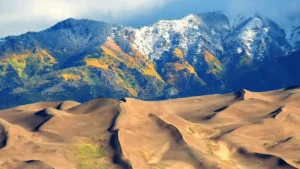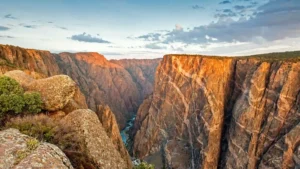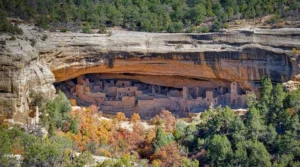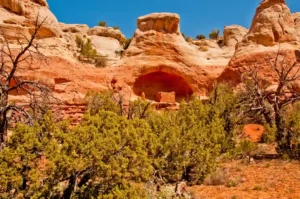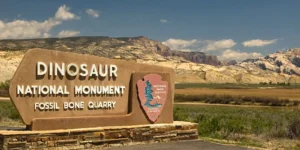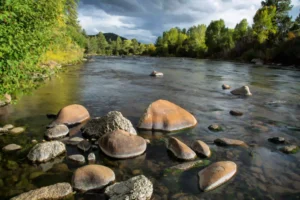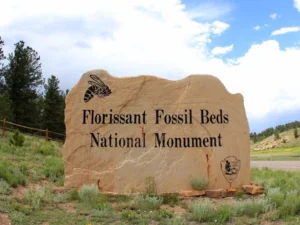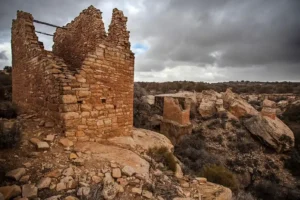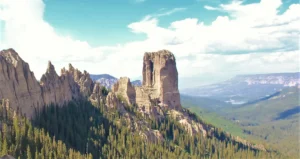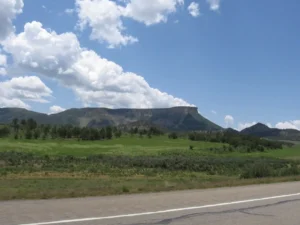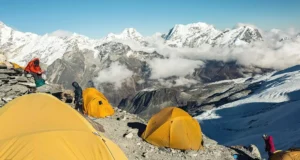Welcome to our list of Colorado’s top 15 parks! We have the best parks in Colorado, each with breathtaking natural beauty and a plethora of recreational options. With their breathtaking scenery, varied fauna, and limitless activities, these parks are sure to enthrall you whether you’re an outdoor enthusiast or just looking for a quiet getaway. Come along as we visit the best parks in Colorado that highlight its natural splendor.
Best Parks in Colorado
1. Rocky Mountain National Park
Among Colorado’s national parks, Rocky Mountain National Park is without a doubt the jewel in the crown. It has striking views and a multitude of outdoor activities with its recognizable peaks and valleys. The park, which goes by the name Rocky Mountain High, is situated in the north-central region of Colorado.
Related – 23 Best & Fun Things To Do In Edison, NJ
Rocky Mountain National Park is a nature lover’s dream come true, nestled amid the mountains. Views of the surrounding sceneries can be had from trails that lead to jagged granite peaks, where visitors can observe spectacular fauna like elk and moose feeding in the verdant valleys. Many of these peaks are thought to be older than 130 million years, and many of them are more than 12,000 feet tall.
The renowned Trail Ridge Road, a picturesque drive that crosses the Continental Divide and provides breathtaking views of alpine lakes, birch trees, and wildlife like moose and marmots, is one of the park’s attractions. The route leads to some of the park’s most breathtaking hiking trails and attractions and brings tourists right into the center of the park.
Although the park is separated into multiple parts, most visitors begin their excursions in Beaver Meadows and Moraine Park, which lies in the center of the park. Well-kept paths can be found here, leading to breathtaking glacier basins dotted with lakes and tumbling waterfalls. For those looking for peace in the great outdoors, the Grand Lake entrance on the west side of the park is an ideal location.
Staying in the forested village of Grand Lake offers guests an unmatched experience. From there, they may ride horses, climb Longs Peak, one of Colorado’s most famous 14ers, see elk in Coyote Valley, or test their rock climbing prowess on the 12,100-foot Mount Ida.
Related – 6 Best Block Island Beaches
Additionally, a wide range of fauna, such as bighorn sheep, black bears, and many bird species, can be found in Rocky Mountain National Park. Those who are interested in wildlife will be delighted to see these creatures in their native environments.
It’s crucial to remember that reservations are now available in Rocky Mountain National Park. It is advised to make reservations on recreation.gov to guarantee entry to the park during busy times.
2. Great Sand Dunes National Park and Preserve
A unique site in Colorado, Great Sand Dunes National Park, and Preserve mixes the grandeur of the Sangre de Cristo Mountains with the splendor of towering dunes. This park, which is in the southern region of the state, allows tourists to see a desert-like environment in the middle of the mountains.
Over thousands of years, winds swept sand particles from neighboring mountains and deposited them on the valley level, creating the Great Sand Dunes. The end effect is a vast, captivating length of golden sand. Wander across the dunes, ride a sandboard or sled down the slopes, or just take in the surreal beauty of the surroundings are all options available to visitors.
Medano Creek, which emerges from the mountains during the spring thaw and meanders through the dunes to create a beach-like paradise where kids may make sandcastles and enjoy the cold water, is one of the park’s attractions. Although the creek eventually dries up in the summer, tourists may still take in the vast stretch of beach and the amazing vistas of the surrounding mountains.
See Also – 25 Best East Coast Weekend Getaways & 2024
Campers at the park’s Piñon Flats Campground, which offers quick access to the dunes and a special chance to see the breathtaking dawn and sunset over the sand, may have a more immersive experience. In addition, backcountry camping is an option for individuals looking for a more private setting.
Beyond the dunes, the park is home to a vast range of plant and animal species due to its various habitats, which include marshes and grasslands. Elk, mule deer, and even the uncommon Rocky Mountain bighorn sheep can be spotted by wildlife enthusiasts.
A real hidden treasure in Colorado, Great Sand Dunes National Park and Preserve provides tourists with a surreal desert experience surrounded by mountains. This park will astound you with the beauties of nature, whether you decide to trek the dunes, swim in the creek, or just take in the beauty of the surroundings.
3. Black Canyon of the Gunnison National Park: A Display of Timeless Erosion
The Gunnison National Park’s Black Canyon is a striking example of ancient erosion and is situated in western Colorado. This deep, narrow canyon, sculpted by the Gunnison River, presents stunning vistas and unusual geological formations.
The towering cliffs and precipitous descents of the Black Canyon are well-known. Some of these are so deep and narrow that sunlight only reaches the bottom for 30 minutes a day. Its craggy topography and black cliffs combine to create a scene as breathtaking as the Grand Canyon.
The park offers numerous chances for tourists to go into the canyon’s depths and take in its striking geological characteristics. Beautiful vistas of the canyon may be seen from scenic drives around the North and South Rims, letting tourists experience the untamed majesty of nature. Popular locations on the South Rim that provide expansive views of the canyon and the surroundings are Dragon Point and Devil’s Lookout.
Although there aren’t any official hiking trails leading into the canyon, skilled hikers with wilderness permits can explore unmarked paths to get a close-up look at the canyon. These climbs can be difficult due to the harsh terrain, so careful planning and preparation are essential. Hikers will be rewarded with a unique viewpoint on the canyon’s spectacular scenery, making the effort worthwhile.
Related – 23 Best & Fun Things To Do In Edison, NJ
Apart from its remarkable geological features, Black Canyon in Gunnison National Park is recognized as an International Dark Sky Park, providing exceptional chances for observing the night sky. During the summer, the park holds sky parties where guests can take guided excursions and discover the mysteries of the night sky.
To get the most out of the park, guests have the option of staying in neighboring Montrose, where there are budget motels, or camping at one of the park’s campgrounds. It is an experience that will never be forgotten to embrace seclusion and take in the untamed beauty of Gunnison National Park’s Black Canyon.
4. Mesa Verde National Park
More than 4,000 archaeological sites may be found in Mesa Verde National Park, some of which date as far back as 650 C.E. The Ancestral Puebloan people formerly inhabited these cliff houses, creating intricate multi-level settlements far above the canyon floor. Visitors can now explore these homes and discover more about the customs and everyday life of the Ancestral Puebloans.
Take a ranger-led tour to see some of the park’s most striking cliff houses, including Cliff Palace, Balcony House, and Long House. These guided tours shed light on the historical background, architectural style, and cultural relevance of these old buildings. Another well-liked hiking trail in the park is Petroglyph Point Trail, which gives breathtaking views of the red rock canyons and the opportunity to see some of the best Indigenous artwork in the area.
Mesa Verde National Park offers outdoor recreation in addition to its amazing archaeological sites. Excellent hiking trails that highlight the natural splendor of the surroundings, including sweeping vistas and animal sightings, are available in the park. Seeing the variety of bird species that call the park home makes birdwatching a popular pastime.
There are just a few lodging options in the park, including a lodge and a single campsite. However, there are more options for hotels, food, and supplies in neighboring towns like Mancos and Cortez.
A must-see location for history buffs, environmentalists, and anybody wishing to learn more about the rich cultural legacy of the Ancestral Puebloans is Mesa Verde National Park. Immersion in the park’s prehistoric past and exploration of the cliff dwellings are genuinely amazing experiences.
5. Canyons of the Ancients National Monument
Tucked away in southwestern Colorado is the hidden jewel known as the Canyons of the Ancients National Monument. This lesser-known park allows visitors to experience walking through prehistoric ages and has one of the highest densities of archaeological sites in North America.
Scattered throughout its rough 176,000 acres, Canyons of the Ancients National Monument is only 12 miles away from Mesa Verde National Park. It is home to over 6,300 archaeological sites. These locations are from approximately 1200 CE and present the artifacts from the region’s prehistoric Puebloan civilization.
The Lowry Pueblo, the main draw of the historic site, is open for exploration by park visitors. This 40-room pueblo building has an amazingly well-preserved grand kiva ceremonial space and offers an intriguing look at old architectural processes. Visitors can learn about the history and culture of the Ancestral Puebloans through interactive displays and demonstrations at the interactive Canyons of the Ancients Visitor Center and Museum, which offers guided tours.
Canyons of the Ancients National Monument offers chances for outdoor pursuits including hiking, wildlife viewing, and photography in addition to its archaeological marvels. It’s a favorite location for nature lovers and photographers trying to capture the beauty of the surrounding surroundings because of the untamed terrain and expansive views.
Although the monument does not have any constructed campgrounds, camping is permitted in the backcountry of the park. Accommodations are available in nearby towns like as Dolores, Cortez, and Mancos for visitors wishing to explore the region.
A hidden gem in Colorado, Canyons of the Ancients National Monument offers a singular chance to travel back in time and fully engage with the rich cultural heritage of the Ancestral Puebloans. Discovering this archaeological treasure trove provides a more profound insight of Colorado’s prehistoric past and is an amazing experience.
6. Dinosaur National Monument
For both nature lovers and fossil enthusiasts, Dinosaur National Monument is an absolute wonder. With its amazing fossils and geological marvels, this unique park—which is situated on the border between Colorado and Utah—offers a view into prehistoric times.
With more than 1,500 dinosaur fossils, the park is renowned for its abundant fossil beds. These fossils are on display in the Quarry Exhibit Hall, where visitors can see them preserved in a cliff wall. The display hall offers a rare chance to view dinosaur bones in their original habitat and discover more about the extinct animals that formerly inhabited the area.
Apart from the remarkable dinosaur remains, the park is home to breathtaking geological formations. At Echo Park, the Yampa and Green rivers meet, forming Steamboat Rock’s nearly perfect horseshoe curve. Hiking and boating are two excellent ways to explore this natural wonder, which offers stunning views of the nearby canyons and rock formations.
Dinosaur National Monument offers a wide range of outdoor activities, including camping in wilderness or authorized campgrounds, hiking beautiful trails, swimming and kayaking in the river systems. The park is a great place to go stargazing because it is an International Dark Sky Park.
The park offers established campgrounds for visitors to stay at, or they can pick from a variety of hotel alternatives in nearby Vernal, Utah, or Dinosaur, Colorado. It is possible to travel back in time to a time when dinosaurs dominated the world by being surrounded by the park’s natural beauties and beauty.
7. Browns Canyon National Monument
In the heart of Colorado, Browns Canyon National Monument is a haven for those who enjoy outdoor adventures. This 22,000-acre monument, which is situated along the Arkansas River, is well-known for its breathtaking whitewater rafting experiences, unique rock formations, and varied animals.
In Browns Canyon National Monument, whitewater rafting on the Arkansas River is the main attraction. There are several distinct portions of the river, from serene float sections to exhilarating Class IV and V rapids with names like Seidel’s Suckhole and Pinball. There are appropriate rafting experiences available for all skill levels, regardless of your experience level.
Browns Canyon National Monument provides many chances for outdoor sports and animal viewing in addition to rafting. Hiking the Turret Trail offers breathtaking views of the surrounding terrain. You may see bighorn sheep sparring on rocky outcrops, black bears fishing in the river, and eagles and falcons soaring across the canyon.
Other outdoor activities available to visitors to Browns Canyon National Monument include rock climbing, horseback riding, camping, and picnics. It is the ideal location for both nature lovers and adventure seekers due to the abundant vegetation along the riverbanks and the stunning views.
Staying in the surrounding artistic communities of Salida or Buena Vista allows tourists to fully enjoy everything that Browns Canyon National Monument has to offer. Excellent lodging alternatives are available, from hotels with European influences to motor lodges with a nostalgic vibe.
A playground for adventure, Browns Canyon National Monument highlights the splendor of Colorado’s natural surroundings. This monument is a refuge for outdoor enthusiasts, offering exhilarating whitewater rafting experiences, breathtaking hikes, and opportunities to see a variety of wildlife.
8. Colorado National Monument
Colorado National Monument, which is located in western Colorado close to Grand Junction, provides tourists with a view of the state’s breathtaking red rock canyons, picturesque roads, and expansive views. This undiscovered beauty is frequently missed, but it offers a singular fusion of stunning geological structures and desert vistas.
The monument is made up of deep gorges, towering red rock canyons, and stunning rock formations. It covers a sizable portion of Colorado’s high desert. Incredible photo opportunities abound as the vivid blue skies contrast sharply with the red sandstone cliffs and spires.
The Rim Rock Drive, a breathtaking route that hugs the canyon walls, is one of the main attractions of the Colorado National Monument. There are other overlooks along the route where guests can pause to take in the expansive views. The drive offers amazing views. Popular hiking route Serpent’s Trail descends into the canyon’s interior, offering a distinctive viewpoint of its untamed splendor.
There are lots of chances for outdoor enthusiasts to engage in activities including hiking, camping, picnicking, and wildlife observation. Numerous animal species, including as bighorn sheep, mule deer, and bird species, can be found in the park. Peregrine falcons, golden eagles, and even the secretive black swift are visible to birdwatchers.
Photographers, wildlife enthusiasts, and anybody looking for seclusion in the breathtaking desert landscape will find paradise at the Colorado National Monument. This monument, which highlights the distinct splendor of Colorado’s plateaus, is a hidden gem that is worth seeing for its picturesque drives, fascinating rock formations, and breathtaking sunsets.
9. Florissant Fossil Beds National Monument
Visitors can delve into Colorado’s prehistoric past at the Florissant Fossil Beds National Monument. This monument, which is situated in central Colorado, protects the old woods and millions of years’ worth of paleontological remains, offering a glimpse into the past.
The striking assemblage of petrified Giant Sequoia trunks, some of which are more than 14 feet in diameter, forms the focal point of the Florissant Fossil Beds National Monument. The amazing fossils of these old trees can be found today because of the volcanic ash deposits that coated the region millions of years ago and preserved the trees.
In addition, the monument has a wide range of other petrified plant and insect fossils that shed light on the prehistoric biodiversity of the area. Discover more about the ancient ecosystem that once flourished here and get up close and personal with these fossils by exploring the park’s varied trail system.
Florissant Fossil Beds National Monument provides chances for outdoor activities like hiking, wildlife viewing, and birdwatching in addition to its fossil beds. several plant and animal species, including as mule deer, black bears, and several bird species, can be found in the park.
Historical buildings, including the Hornbek Homestead, provide insight into the early settlers’ way of life. Self-guided tours of these buildings are available for visitors to learn about the history and culture of the area.
Although Florissant Fossil Beds National Monument does not allow camping, people who want to further explore the area can find hotel choices in neighboring communities like Woodland Park and Florissant.
For individuals who are interested in paleontology and the prehistoric past of Colorado, the Florissant Fossil Beds National Monument is an intriguing place to visit. Witnessing the petrified remnants of old trees while strolling through the ancient forest is a very unique experience that takes tourists back in time.
10. Hovenweep National Monument
A little-known treasure tucked away on the Colorado–Utah border is Hovenweep National Monument. Visit this lesser-known location to witness amazing historic sites and ancient constructions constructed by the ancestors of the Pueblo people.
The striking 13th-century ruins that makeup Hovenweep National Monument are its defining feature. The park showcases the architectural prowess of the ancestors of the Puebloans with its assortment of well-preserved towers and monuments located on precipitous cliffs. The Square Tower, which is the most notable building, is three stories high and has elaborate stonework.
Hiking routes wind through the park’s untamed terrain, offering access to several ruins and vistas, and are open to visitors. Through interpretive signage, visitors can learn about the cultural and historical significance of the sites while enjoying spectacular views of the neighboring canyons from these pathways.
Hovenweep National Monument does not allow camping, however, there are lodging choices close by in Cortez, Colorado, and Blanding, Utah.
Hovenweep National Monument provides a window into the rich cultural past of the indigenous Puebloans and is a real monument to their inventiveness. Visitors will be in awe of the artistry and tenacity of these ancient civilizations after exploring these amazing old structures.
11. Chimney Rock National Monument: A Sacred, Solitary Landmark
Southern Colorado’s Chimney Rock National Monument is a revered site that provides a rare window into the past for tourists. This less well-known location is well-known for its astronomical occurrences and archaeological ruins.
For the ancient Puebloans who lived in the area more than a millennium ago, Chimney Rock National Monument served as a hub for both ceremonial and commercial activities. The huge kiva, a sizable circular room used for ceremonies, is located in the park. The diverse cultural customs and spiritual practices of the prehistoric people are revealed at this location.
Chimney Rock National Monument is well-known for its connections to astronomical occurrences in addition to its archaeological treasures. The significance of the location in prehistoric astronomical observations is highlighted by the peculiar alignment of Chimney Rock and nearby rocks with the moon at specific times of the year.
The park’s interpretative trail system, which affords breathtaking views of the surroundings and offers details on the historical and cultural value of the area, is open to visitors. During the summer, you may experience the mystique of the place and learn from professional instructors by signing up for guided tours.
Although camping is not permitted within the monument, there are lodging alternatives in Pagosa Springs and Bayfield, which are nearby.
A lonely and hallowed site, Chimney Rock National Monument honors the past and its relationship to the heavens. Despite its lesser-known status, this location offers travelers interested in southern Colorado’s cultural heritage a rich and educational experience.
12. Yucca House National Monument
Southwest Colorado is home to the archaeological treasure trove known as Yucca House National Monument. This unearthed site protects the area’s cultural legacy and provides tourists with a window into the ancestors’ Puebloan society.
The ruins of Yucca House National Monument can be seen in their unaltered state because the area is still mostly unexplored. The monument is home to the remnants of a sizable pueblo complex that the ancestors of the Pueblo people lived in between the 12th and 13th centuries. Explore the site to view the stone walls, courtyards, and other buildings that provide a window into the everyday life of the prehistoric occupants.
Numerous archaeological elements, such as kivas, storage pits, and pieces of pottery, can be found within the site. These ruins demonstrate the Puebloan people’s capacity for building intricate structures and offer important cultural and historical details about their ancestors.
With self-guided tours that include interpretive signage on the history and significance of the site, visitors can explore the monument independently. Yucca House National Monument is a rare location where tourists may see the antiquities in their original condition because there hasn’t been any excavation.
Although Yucca House National Monument does not allow camping, there are accommodation choices in Cortez and Durango, which are nearby.
For those who are interested in Puebloan ancestry and archeology, Yucca House National Monument is a veritable gold mine. The site’s untouched condition only heightens the attraction, evoking a sense of mystery and wonder as tourists investigate the ruins and try to picture the lives of the prehistoric occupants.
13. Curecanti National Recreation Area
Tucked away in the heart of Colorado is the picturesque Curecanti National Recreation Area. This haven for water enthusiasts offers a plethora of recreational possibilities and is home to the breathtaking Blue Mesa Reservoir.
At more than 9,000 acres, Blue Mesa Reservoir is Colorado’s largest body of water. Water activities, fishing, and boating are all quite popular there. In addition to lounging on the sandy beaches and soaking in the sun, visitors can rent kayaks, paddleboards, and boats to explore the reservoir.
There will be plenty of chances for anglers to test the waters in the reservoir. Numerous fish species, including trout, salmon, and Kokanee salmon, can be found in Blue Mesa Reservoir. The reservoir is a popular fishing location because of its trophy-sized trout.
Curecanti National Recreation Area has hiking routes that loop through the surrounding hills and offer breathtaking views of the reservoir and adjacent scenery in addition to its water sports. Opportunities to see mule deer, elk, and several bird species can be had on these trails.
There are many places to camp in Curecanti National Recreation Area. Several established campgrounds are located close to the reservoir. These campsites provide an opportunity to completely immerse oneself in the area’s splendor, together with modest utilities and breathtaking views.
Water sports enthusiasts and environment lovers will find peace and tranquility in Curecanti National Recreation Area, which offers a tranquil getaway surrounded by the stunning reservoir and the untamed surroundings of central Colorado. This recreation area is likely to please guests of all ages, whether you choose to boat on the reservoir, hike along its banks, or just take in the gorgeous vistas.
14. Summit Lake Park: A High Altitude Oasis
Situated atop Mount Evans, the highest peak in Colorado, is Summit Lake Park, a veritable hidden treasure. This alpine park, which is 12,830 feet above sea level, offers amazing panoramic vistas, alpine tundra, and rare fauna.
The Mount Evans Scenic Byway offers a scenic journey through the mountains and leads to Summit Lake Park. Numerous hiking paths snake through the alpine tundra in the park, providing breathtaking vistas of the nearby peaks, wildflowers, and fauna.
Marmots, several bird species, and Rocky Mountain bighorn sheep can all be seen by tourists living in the tundra. The park offers a one-of-a-kind experience for both nature lovers and photographers due to its high altitude and distinctive environment.
Summit Lake Park has picnic spaces, restrooms, and a visitor center with educational displays and details on the natural history of the park. Due to the high altitude’s potential to magnify the sun’s rays, visitors are advised to pack sunscreen and wear warm clothing.
Offering a secluded haven at a high altitude, Summit Lake Park offers a calm diversion from the daily grind. For individuals who love the outdoors and want to have a once-in-a-lifetime mountain experience, it is a must-see location because of the expansive views and distinctive alpine ecology.
15. Eldorado Canyon State Park: A Gold Rush Legacy
Situated south of Boulder, Colorado, is a hidden gem: Eldorado Canyon State Park. This park allows tourists to engage in outdoor activities in an amazing environment while fusing the untamed beauty of the mountains with the rich history of the gold rush.
Because of its well-known rock climbing spots, Eldorado Canyon draws rock climbers from all over the world. Climbers of all abilities find the park’s sheer walls and high sandstone cliffs to be a refuge. There are plenty of routes and challenges to choose from, ranging from easier climbs for beginners to more difficult ones.
Eldorado Canyon State Park provides a range of outdoor activities in addition to rock climbing. Hiking routes wind through the picturesque parts of the park, providing chances to discover the natural beauty of the canyon and breathtaking views of it. The park is a well-liked location for picnics, fishing, and wildlife observation. Guests can see foxes, golden eagles, or even mule deer flying overhead.
Eldorado Canyon State Park has a rich history that dates back to the late 1800s Gold Rush. Even today, one can still see the ruins of the Crags Hotel, which was constructed during the gold rush. Interpretive signage positioned throughout the paths offers valuable perspectives into the region’s abundant cultural legacy and gold mining past.
Eldorado Canyon State Park provides campgrounds with tent and RV sites for camping. However, due to great demand, reservations are needed for camping.
Eldorado Canyon State Park provides a special fusion of historical significance, natural beauty, and recreational activities. This park is sure to make an impression, whether you’re trekking along the paths, climbing the canyon walls, or just taking in the peaceful atmosphere.
What to Anticipate from These Park Visits
Colorado’s parks offer a wide variety of scenery and an abundance of species. Every park offers a different experience, from the ancient cliff dwellings of Mesa Verde to the towering cliffs of Black Canyon of the Gunnison. Activities for outdoor enthusiasts include rock climbing, horseback riding, and animal observation. Historic buildings and archeological sites provide additional opportunities for visitors to learn about the rich past. These parks offer a wide range of recreational activities, making them a sanctuary for both adventurers and nature enthusiasts.
Plenty of Wildlife: An Overview of Colorado’s Biodiversity
The parks of Colorado provide a window into the great biodiversity of the state by exhibiting a wide variety of ecosystems and an abundance of species. Visitors can come across a diverse range of wildlife, from the majestic Rocky Mountain elk in Rocky Mountain National Park to the elusive black bears in Browns Canyon National Monument. The parks are a paradise for those who enjoy the outdoors and animals since they are home to bighorn sheep, uncommon bird species, and ancient petroglyphs.
Diverse Terrain: From Ice Ages to Deserts
Colorado provides an incredible diversity of scenery, from the rolling dunes of Great Sand Dunes National Park to the untamed canyons of Black Canyon in Gunnison National Park. The state is home to a variety of landscapes, including glaciers and a surreal desert. Within the borders of Colorado’s national parks, visitors can explore scorching deserts, alpine tundra, and lush woods. Colorado is a genuinely unique location for both nature enthusiasts and adventure seekers because of its variety of terrain.
Outside Activities: Camping, Hiking, and Other Things
Colorado’s parks provide a wealth of outdoor activities for those who like the great outdoors, including stargazing and hiking across challenging terrain. All adventure lovers will find something to enjoy in the varied settings, which offer chances for rock climbing, equestrian riding, and wildlife observation. Camping among the dunes, hiking among historic cliff houses, and exploring trails that lead to undiscovered historical sites are all available to visitors. Colorado’s national parks are an outdoor enthusiast’s paradise, offering activities like driving through picturesque scenery and ascending rock formations.
How to Get Ready for the Colorado Parks Visit
Make sure you’re ready before you head out on your fantastic Colorado park excursion. It’s important to bring the right equipment for outdoor pursuits like hiking and animal viewing. It’s advisable to prepare for a range of weather situations because the parks feature a variety of environments, from glaciers to deserts. Your experience can be improved by selecting the ideal time to come, taking into account things like recreational options and wildlife migration patterns. It’s also essential to become acquainted with the unique rules and restrictions that apply to each park to guarantee a trouble-free and delightful stay.
Important Items to Bring on Your Trip
It’s important to bring essentials for trips to Colorado’s top parks when getting ready for them. Make sure you bring the right equipment for trekking, such as supportive boots, clothes suitable for the weather, and a cozy backpack. When going on outdoor outings, don’t forget to pack lots of water, sunscreen, and insect repellent. A camera is also essential to capture the amazing wildlife and landscapes. For a safe and pleasurable visit to Colorado’s wildlife reserves, don’t forget to bring refreshments, a first-aid kit, and a trail map.
The Ideal Time to Go to the Parks
The ideal time to visit Colorado’s parks primarily relies on individual choices for activities and weather. The summer months of July and August provide comfortable weather for outdoor activities like hiking and camping. This season can get congested, though. September and October are prime times for fall foliage and cooler temperatures. Spring offers wildflowers and fewer tourists, especially in May and June. Winter, which lasts from December to February, is the best time to visit the parks and enjoy the quieter side of things. Every season has a distinct charm that appeals to a wide range of interests.


